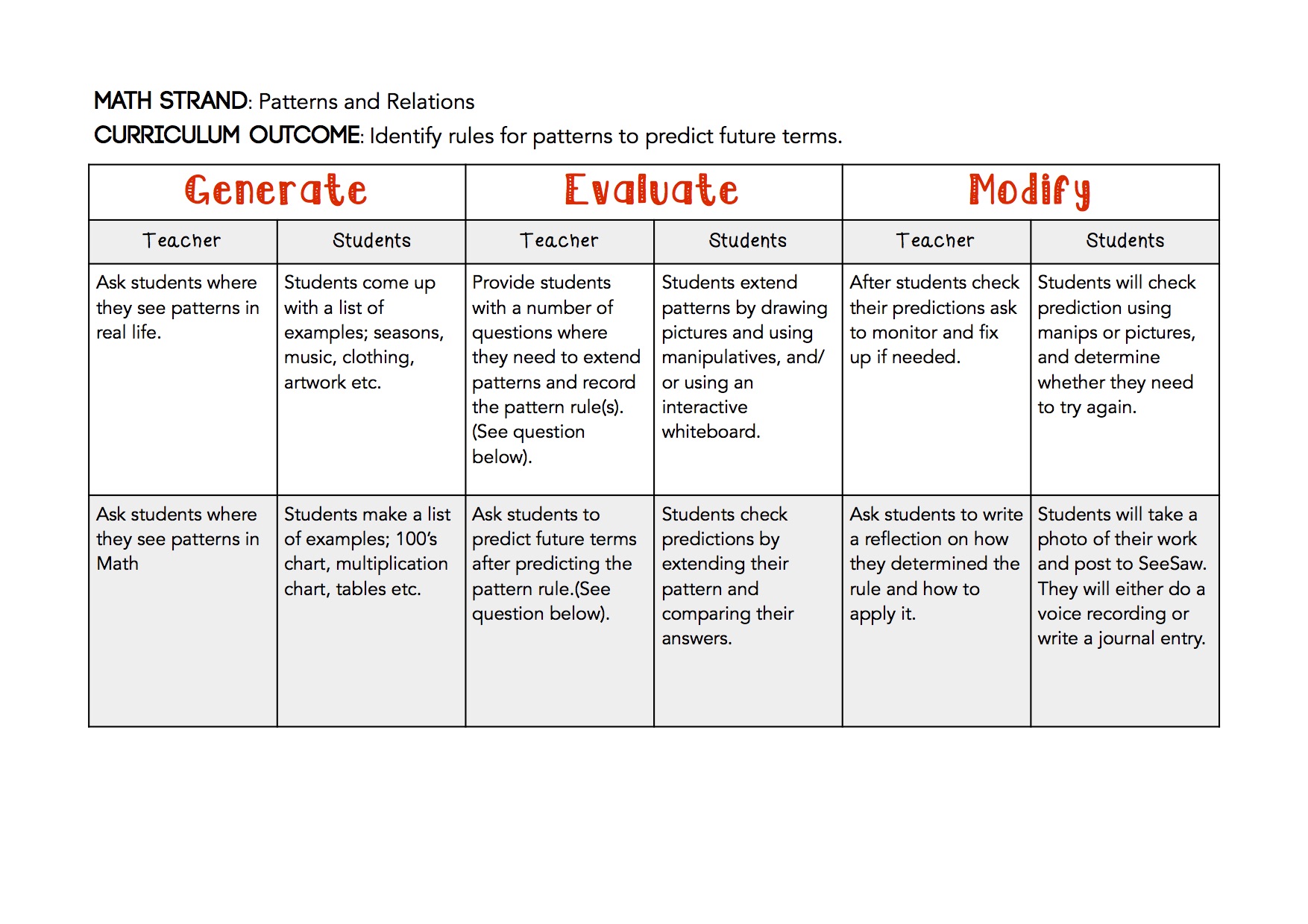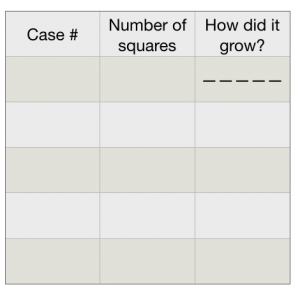Similar to the LfU model, I appreciate how the T-GEM approach to teaching is through inquiry. I chose to create a lesson around a ‘Patterns and Relations’ outcome. In my experience, in the early years, students have a strong understanding of how to identify, extend and replicate simple patterns such as AB patterns, ABC etc. Next steps in their conceptual understanding is to identify pattern rules for increasing and decreasing patterns and then apply them to an algebraic equation. This is a concept that many students in Grades 4 and 5 struggle with. I teach Grade 3, and our goal is to prepare students for this by having them predict future terms by analyzing and thinking about patterns critically. In the plan outlined below, I integrated technology as both an optional tool for students to use in their investigation, and as a tool for students to explain their thinking. As Khan (2007) explains, this is a cycle that students should go through many times, therefore students would be asked to repeat the ‘evaluate’ and ‘modify’ activity in different ways to help achieve mastery.  Example question for ‘Evaluate‘
Example question for ‘Evaluate‘
Replicate the models below by making a drawing, using tiles, or using your interactive whiteboard. Identify the pattern rule and then make Case 4 and 5.
Fill in the table below.
Analyse the pattern rule. Can you predict what Case 7 would look like? How many tiles would it use? Case 10? Make your predictions and then check your answer by building each one.


References:
Khan, S. (2007). Model-based inquiries in chemistry. Science Education, 91(6), 877-905
Hello Sarah,
I really liked your lesson idea as I feel these skills are creating an excellent foundation for whats to come in their math lessons later on. In your evaluate section, I recognised the type of question as something that comes up on the grade 6 exams in the UK but at a smaller scale. The students in my grade 6 class may be shown a pattern and asked: What could case 57 look like? What about case 100? As you mentioned, analyzing and thinking about patterns critically is an essential skill. Another point in your lesson that resonated with me was that a student should go through this cycle several times. I think if we take on a T-GEM approach to some lessons, that each time use this method, it becomes easier. For example, students are more confident in creating their hypotheses and we as teachers are more comfortable in letting them. Repetition and consistency can be beneficial. Thanks for your post!
Kathryn
Thanks, Kathryn,
Yes, we have similar outcomes in Grade 6 so try and scaffold the learning as much as possible. One thing we are currently struggling with is how to differentiate instruction. There are students who are ready to start looking at writing the algebraic equation for a pattern while others are still not able to recognize them and are still working with simple patterns that you would see in grade 2. This unit, in particular, is one that I find has such big leaps between levels.
Sarah
Hi Sarah
I like the fact that you used a visual presentation.
I wonder if teachers talk to the next years’ teacher to see what they expect from their students. For example, in the twenty plus years, I have been teaching science 8 — I have only discussed once with a grade 7 teacher my science expectations that grade 7 students should have.
A good next step might be to think about how you would do this same lesson with a student that is visually impaired.
Christopher
Hi Christopher,
At my last school, we were fortunate enough to have two extended planning sessions a year where we got to discuss Math strands with the grade below and above us. Once a year we even collaborated with the secondary school to examine how we can better prepare our students who were moving in middle school. These sessions were so valuable because it allowed us to identify and address things like school-wide misconceptions and gaps, uncover any overlap, where our students excel etc. In my current school we do not have this type of planning in place, but after a lot of discussions, I am hopeful that we can make it happen!
Hi Sarah,
The inquiry approach in your activity resonates to me. I like how you paved the way for your students to think critically to describe the pattern and generate the next term in the series. Pattern investigation can be challenging even for Middle and High school students. Usually my students are able to guess the next terms in a series, and provide a description of how pattern progresses. They will explain the rule but will fail to write a formula that describes the rule; that is to give the number of squares in term of the case number, referring to your example. The challenge is higher when the pattern in the series is decreasing instead of increasing. Do your students also struggle more with decreasing patterns?
Vivien
Hi Vivien,
Yes, like you I notice that students have a harder time identifying and analyzing decreasing patterns. It’s interesting that with most Math strands students struggle with the inverse operation i.e. have a harder time with division that with multiplication, and harder time with subtraction than addition.
Would you agree?
Cheers,
Sarah